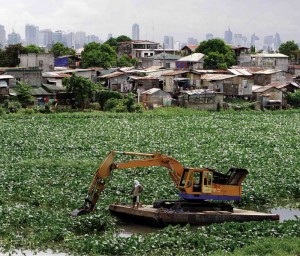COA scores Pasig River rehab for junky cleanup

RIVER KILLER Water lilies surround a dredger at the Manggahan Floodway in Cainta, Rizal, which was built in 1986 at the cost of P1.11 billion to reduce flooding along Pasig River. RAFFY LERMA
The Commission on Audit (COA) has scored the Pasig River Rehabilitation Commission (PRRC) for creating more junk rather than removing rubbish when it bungled its P17.7-million cleanup of Metro Manila’s biggest waterway.
In its 2012 report, the COA said that millions of pesos worth of recycling equipment had been rendered junk because the PRRC had only one working materials recovery facility (MRF) out of the 10 recycling centers it committed to build over the last four years.
“(This is) tantamount to wastage of government funds and deprived the intended beneficiaries of the benefits that could have been derived therefrom,” the COA said.
In an e-mail, Regina Lopez, the PRRC chair and ABS-CBN Foundation director, said she expected to complete the MRFs within the year.
“When I first took over, my initial strategy was to do something about solid waste management. At that time, I thought that this was the way to clean the Pasig River. The equipment was delivered; however, the MRF sites were not finalized. Now the MRF sites are finalized and are currently under construction. The sites should be completed by this year,” said Lopez, the PRRC chair since April 2010.
The MRFs were supposed to anchor the establishment of clean river zones (CRZs) along the Pasig River. The MRF package includes a shredder, oven smelter and baler to recycle the garbage collected by the CRZ and provide livelihood as an incentive to reduce wastes in the community.
The PRRC awarded a P9.9-million contract to Linear Construction Corp. in May 2009 to build 10 MRFs until Jan. 17 this year. The company has managed to build only four MRFs (of which only one, at Addition Hills, Mandaluyong City, was working) before the deadline while the remaining six were less than 25 percent complete.
The COA said the MRFs at the Department of Environment and Natural Resources (DENR) compound, Polytechnic University of the Philippines (PUP) compound, and Cardinal Sin Village at Punta, Sta. Ana, in Manila, costing P1.908 million were found “nonoperational and almost deteriorated due to the rain, heat and stray animals living inside the structures.”
PRRC’s mismanagement was evident in its decision to purchase in advance the equipment for the MRFs even before their sites had been ready. In 2009, PRRC awarded an P8.631-million contract to Metro Waste Solidwaste Management Corp. to supply 188 equipment to the MRFs. However, only 47 of the equipment have remained with the PRRC. The rest were donated to local government units.
No storage facility
Without the MRFs, the COA said the equipment purchased for these facilities were not stored properly.
“Considering the length of time since the equipment was purchased, its operational efficiency has already diminished which may render it inoperable by the time all MRFs are completed. This could be attributed to the noncompletion of MRFs on time. We were informed that the PRRC has no storage facility which would accommodate all the equipment hence, they were distributed to various locations where the MRF projects are to be constructed,” the COA said.
The COA recommended that the PRRC rehabilitate the three idle MRFs and complete the remaining six MRFs to save the equipment from further deterioration. The COA also suggested that PRRC officials coordinate with government officials to look for warehouses to store the MRF equipment.
Warning flag
As early as 2011, the COA had already raised a warning flag on the wastage caused by the PRRC’s inability to follow through its program to clean up the Pasig River.
PRRC executive director Ronald Naguit said PRRC had addressed some of the COA’s concerns, specifically the 12 equipment at the DENR compound by covering these with canvass sheets and detaching their motors to prevent further deterioration.
Naguit said that the MRF at Sta. Ana was being operated in partnership with the Cardinal Sin Village administration, while the MRF at the PUP Sta. Mesa was initially operated by PRRC in tandem with Kapit Bisig Para sa Ilog Pasig.














